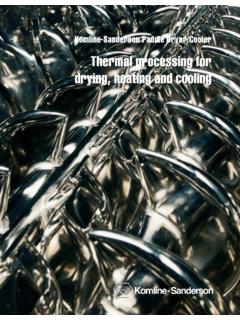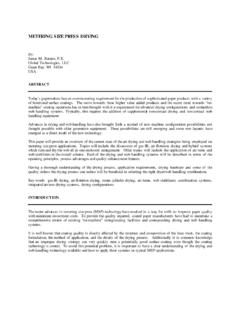Transcription of Rotary Drum Vacuum Filters - Komline-Sanderson
1 Rotary drum Vacuum Filters for Production of Wallboard-Grade Gypsum paper #19 Kevin Hibbert NB Power, 515 King Street, Fredericton, NB E3B 5G4 Canada Carl Weilert Burns & McDonnell Engineering Company, 9400 Ward Parkway, Kansas City, MO 64114 Thomas O Leary Komline-Sanderson , 12 Holland Avenue, Peapack, NJ 07977 ABSTRACT Conventional wisdom is that production of wallboard-grade FGD gypsum requires the use of horizontal belt Vacuum Filters for dewatering service, to limit cake moisture to 10% or less. New Brunswick Power initially planned to use HBVFs for gypsum dewatering for the FGD retrofit to its 3 x 350 MW Coleson Cove plant. However, project budget constraints led to cost reduction evaluations which identified potential cost savings if Rotary drum Filters could be used instead. This paper documents the cost saving considerations that led to the substitution, including improved building arrangement, reduced equipment cost, and reduced power requirements.
2 The operating performance results of the Rotary drum Vacuum Filters at Coleson Cove are presented, proving the capability to produce wallboard quality gypsum filter cake with moisture content as low as 6%. Key aspects of the design and operation of the Filters that make Rotary drums a viable choice for dewatering are presented. INTRODUCTION This paper will introduce the reader to the idea of using Rotary drum Vacuum Filters (RDVFs) to dewater wallboard grade gypsum produced by FGD facilities. In the past, typical practice was to use RDVFs for disposal grade gypsum only, with horizontal Vacuum Filters used for dewatering commercial grade gypsum. Today, several FGD systems incorporate new high-rate RDVFs to produce commercial grade gypsum. Other stations have converted to fully oxidized gypsum production and use existing RDVFs. These include NIPSCO Schahfer Station and LG&E Mill Creek Station. After converting to a forced oxidation system NIPSCO Schahfer now produces a gypsum filter cake.
3 The gypsum filter cake produced must have a moisture content of less than 15% and a chloride content of less than 100 ppm to meet wallboard manufacturers requirements. The Filters , which were installed in the early 1990 s typically operate in the 13% moisture range. Gypsum filter cake travels from the FGD building by conveyor to the wallboard plant next to the power station. Several stations have specially designed Rotary Vacuum Filters capable of producing wallboard grade gypsum with a filter cake moisture content of less than 10%. The K-S High-Rate FGD drum Filters operating at CWL&P Dallman, TECO Big Bend, and NB Power Coleson Cove 1 Stations all produce a wallboard grade gypsum product. The use of these Filters resulted in substantial savings for the utility in installation cost and operating cost. Space savings were also considerable compared to the space needed for belt Filters . The one thing these stations have in common is the use of RDVFs for producing a wallboard quality gypsum product instead of horizontal belt Vacuum Filters , even though the RDVF was normally considered to be incapable of meeting the low cake moisture requirement of FGD gypsum filter cake.
4 The focus here will be to show how the Rotary drum Vacuum filter can be used to produce a commercial quality gypsum byproduct from an FGD system to meet the wallboard manufacturer s specification. Also presented is information showing how the utility can save capital and operating cost by using the RDVF compared with the HBVF. This paper presents an overview of FGD system operating conditions that will produce a saleable wallboard quality gypsum filter cake. Certain criteria must be met to ensure that the filter cake meets the wallboard manufacturer s requirements. Among these are particle size distribution, crystal shape, and filter feed characteristics such as feed slurry concentration, feed temperature and cake wash temperature. Attention must be paid to these issues (whether for RDVF or HBVF) in order to achieve success. The FGD system at Coleson Cove Station is given as an example of how a system can be designed to save money while at the same time producing the desired product.
5 2 FGD SYSTEM GYPSUM PRODUCTION Flue Gas Desulfurization systems are meeting a worldwide need to remove sulfur dioxide from power station exhaust gas. Wet scrubbing of the flue gas using limestone slurry is a common means of performing this task. The reaction of the flue gas and limestone produces a slurry composed of water, calcium compounds and other constituents. Forced oxidation of the FGD slurry produces a stream with a high percentage of calcium sulfate (gypsum) suitable for use in wallboard production or cement manufacturing. Slurry that is not fully oxidized produces a disposal grade material suitable for landfill. The processing of these slurries is often accomplished using hydrocyclones as the primary dewatering device and Vacuum drum or horizontal belt Filters for secondary dewatering. Sale of byproduct gypsum filter cake allows the utility to recoup some of the expense of installing the FGD system. Gypsum filter Cake for Wallboard For the production of wallboard, the calcium sulfate concentration of the slurry solids must typically be greater than 95%.
6 The gypsum slurry must be dewatered and the solid filter cake must be washed to remove contaminants to meet the wallboard producer s requirements. filter cakes must typically be dewatered to a maximum moisture content of 10% by weight and with a maximum of 100 ppm of chlorides on a dry weight basis. These criteria vary, however, from one wallboard manufacturer to the next. In some cases, the manufacturer will use a filter cake with higher moisture or with higher chloride concentration. The manufacturer might also allow off-spec material but pay for it at a reduced price to the utility. The particular needs of the wallboard producer are important considerations when specifying a filter cake solids concentration. If the design calls for a gypsum byproduct of a higher quality than required by the end user, the result is wasted expense by the utility. The utility should also adopt a flexible approach to processing the gypsum slurry to allow for future developments.
7 Critical Influences for Effective Dewatering Certain process variables must be taken into account in order to ensure that the filter (either RDVF or HBVF) will produce a high quality filter cake meeting the requirements noted above. Important characteristics of the slurry are the gypsum particle size distribution, the crystal shape, the feed slurry solids concentration and the feed temperature. Other variables related to the process design are cake wash water temperature and wash rate, Vacuum pump sizing, and filter cake drying time, which is a function of filter geometry and operation. Particle Size Distribution The particle size distribution of the slurry feed to the filter must be 95% greater than 10 micron. In order to accomplish this, the gypsum slurry must have been classified using a hydrocyclone unit. Today, this is typical practice for FGD primary dewatering, although in past systems the use of settling thickeners was standard practice. Hydrocyclones thicken the slurry to an acceptable filter feed solids concentration while at the same time providing a means to remove excess fines and chlorides from the system.
8 Table 1 shows a particle size distribution for a filter 3 feed slurry having excellent dewatering characteristics. Note the very low percentage of fines being fed to the filter . Table 1. FGD Gypsum Particle Size Distribution Hydroclone Underflow Coleson Cove Station, NB Power Size % Pass % Chng Size % Pass % Chng
9 Crystal Shape The individual particle crystal shape is also an important consideration in order to achieve effective washing and drying of the filter cake. The aspect ratio of the gypsum particles should be no more than 4:1. In relative terms, the following diagram shows three different particles, a normal rhomboid, a needle shaped crystal and a platelet.
10 As can be seen from the diagram in Figure 1, the relative surface area of the normal crystal is much lower than the other two. The greater the surface area a particle has, the more moisture it will hold. As the diagram shows, needle or plate shaped crystals can have close to two times the surface area of rhomboid shapes. 4 Figure 1: Effect of Crystal Shape on Particle Surface Area 4 1 1 4 .5 8 .5 4 .25 Normal Shape Volume 4 Surface Area 18 Normal Shape Volume, each 2 S. A. each Total Vol. 4 Total 33 Platelet Shape Volume 4 Surface Area 36 filter Feed Slurry Concentration The percentage of suspended solids in the filter feed slurry is a very important factor affecting the performance of the filter . The main characteristic affected by slurry feed concentration is cake formation time.








